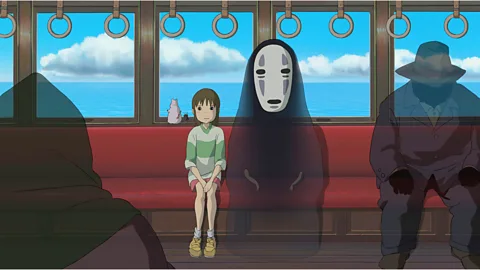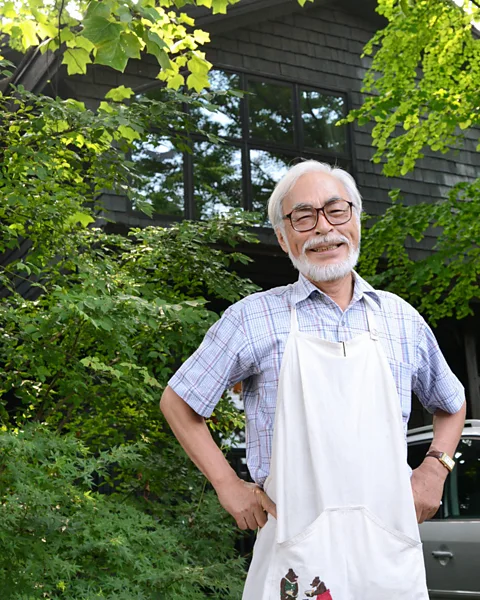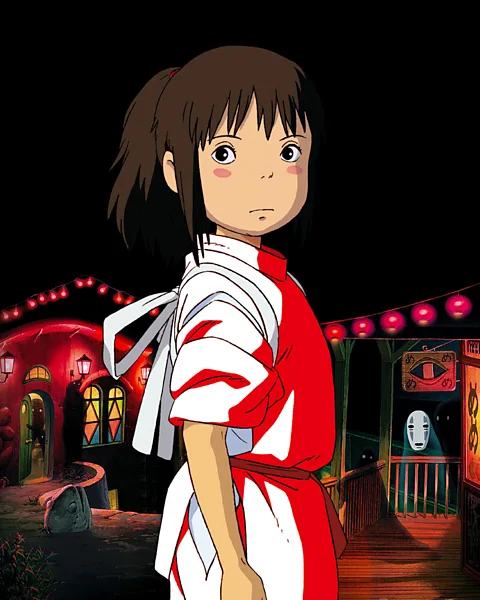The film that captures millennials' greatest fear
 Alamy
AlamyAs Hayao Miyazaki's Oscar-winning anime turns 20, Arwa Haider asks why the film's powerful magic still captivates today.
Within the first 15 minutes of Hayao Miyazaki's Oscar-winning 2001 anime feature Spirited Away, the world has transformed. We find ourselves lost in some kind of enchanted realm with 10-year-old heroine Chihiro, whose parents have taken a diversion on their move to a new home; the film charts her arrival and adventures in a world ruled by spells, spirits and sorceresses. While her mother and father are charmed by these unexpected surrounds (mossy shrines, enigmatic signs, a strangely deserted restaurant feast), Chihiro is instinctively creeped-out. As dusk falls, accompanied by Joe Hisaishi's shiver-inducing score, we are enveloped in the shifting landscape – folkloric and pastoral, now neon-tinged; we are captivated, with seemingly no way back.
More like this:
Spirited Away was certainly not the first Japanese animation to reach a global mainstream – 1961 saw the US cinema distribution of Magic Boy and The Tale Of The White Serpent from Tokyo-based studio Toei Animation; generations of kids worldwide have grown up with multi-genre anime TV series, from Science Ninja Team Gatchaman (aka Battle Of The Planets) to Pokemon; the film adaptation of Katsuhiro Otomo's explosive Akira (1988) renewed mass interest in anime. Yet two decades on from its original release, Spirited Away retains its bewitching power: as an extraordinary gateway into anime as a unifying form, and into themes of environmentalism, supernaturalism and humanity that are deeply rooted throughout Miyazaki's works, and feel more resonant than ever. Even the name of Miyazaki's Studio Ghibli is vividly elemental ("ghibli" is an Italian term, itself derived from Arabic, meaning "hot desert wind").
Writer, commentator and translator Dr Jonathan Clements, whose published works include comprehensive encyclopaedias of anime and Japanese TV drama, notes that while established fans had no doubt of Miyazaki's credentials, Spirited Away's Oscar win was "a wake-up call for a lot of people in the film business who had been disregarding Japanese animation for years".
It prompted a behind-the-scenes rights-rush, as several movie companies hoped to cash in on anime releases; it also represented a high point in Disney's then-distribution partnership with Studio Ghibli, which raised broader global awareness of its catalogue. Throughout this tale, nature is intrinsically magical; humans often seem comparatively graceless, destructive, and given to disastrous materialism. As Clements also points out, the eco-focus of Spirited Away was natural territory for Miyazaki and his peers, and has added to the film's universal appeal.
 Alamy
Alamy"Studio Ghibli in general has always been interested in environmental themes," says Clements. "Part of it is born out of their own genuine concerns for the environment, and partly it's a geographical awareness born from the fact that the studio itself is based in a new town in the Tama Hills that used to be open countryside. You get a sense of that most poignantly in [Studio Ghibli co-founder] Isao Takahata's Pom Poko (1994), when the creatures briefly return the town to the way it looked before the trees were cut down and the ponds filled in.
"Some film companies have adopted eco themes as an easy grade, but Miyazaki has a love not merely of sustainable environments, but also of the right of children to be children. My Neighbor Totoro (1988) in particular was a glimpse of country life for latchkey kids stuck in dormitory suburbs, and I think Spirited Away takes that further, allegorising the constant pressures and distractions of modernity, for a little girl who just wants to be normal, but doesn't know what normal is any more, and sees her parents succumbing to temptation and greed."
Throughout numerous Miyazaki films, we experience a nostalgia for the natural world, respect for spirit realms (and Shinto traditions), and concerns about climate change, along with narratives where young girls and boys tend to be far braver and smarter than their elders. This includes Miyazaki's 1978 directorial debut TV series Future Boy Conan (set in a post-apocalyptic 2008!) and his 1984 manga adaptation Nausicaä of the Valley of the Wind, where a courageous princess/eco warrior traverses a sci-fi Toxic Jungle, as well as the forest-set battles of Princess Mononoke (1997).
 Alamy
AlamyMiyazaki himself hasn't always sounded upbeat on environmental matters; in a 2005 interview in The New Yorker, he exclaimed: "Our population could just suddenly dip and disappear! I talked to an expert on this recently, and I said; 'Tell me the truth'. He said with mass consumption continuing as it is we will have less than 50 years… I'm hoping I'll live another 30 years. I want to see the sea rise over Tokyo and the NTV tower become an island. I'd like to see Manhattan underwater… Money and desire – all that is going to collapse, and wild green grasses are going to take over."
And yet, as we see in his films (and their intriguingly ambiguous "baddies"), there remains a capacity for positive transformation. In Spirited Away, Chihiro befriends a mysterious "Dragon Boy", and is forced to work in an opulent bathhouse owned by the grotesque witch Yubaba (who seizes Chihiro's identity, and renames her "Sen"). In one pivotal scene, Chihiro is enlisted to help wash a hulking "stink spirit" who has visited the bathhouse. Amid the messy chaos, Chihiro treats the creature with gentle compassion, and it transpires to be a sacred river spirit who had suffered from human pollution. Miyazaki has explained that he drew from his own youthful experience of helping to clean a local river, removing random detritus including an abandoned bicycle, and eventually watching wildlife return to the waters.
It's also worth noting that another much-loved fictional hero (and the Studio Ghibli mascot), cuddly spirit Totoro, also lends his name to a real-life environmental Totoro Fund, dedicated to preserving Japan's lush Sayama Hills region, which inspired Miyazaki's anime.
A child's eye view
Part of the enduring magic of Spirited Away is its glorious depth of detail. Its "everyday" heroine Chihiro was inspired by Miyazaki's young family friends; she remains relatable in the most fantastical environs – and helps us to relate to surrounding characters, too: looming, masked No-Face, or six-armed "boiler geezer" Kamaji. There are intricate layers of coding within the exquisite hand-drawn artwork and narrative twists, whether it's over-indulgent adults mutating into pigs ("People in Miyazaki films turn into pigs when they lose sight of their dreams, when they gorge themselves on unimportant, wasteful things and don’t think about what really matters in life," explains Clements), or the Japanese script that unfortunately gets lost in the Netflix translation.
"My favourite scene from Spirited Away is actually when they are wandering through the town in the beginning, because for certain audiences it creates an incredible sense of tension," says Clements. "The English-language version doesn't translate the signs all around Chihiro's family in the street, but they are all goblin-market-level creepy. That's not an opticians, it's an "eyeball shop", and it's even advertising FRESH ONES just in… There are other ones that simply read FLESH or MEAT, and another one that just says GHOSTS. If you are Japanese, this ghost town is already somewhat unsettling, even before the night comes. On a hunch, I showed it to a group of Japanese viewers, and asked them why that scene made them feel uneasy. None of them could say why, until I talked them through all the signs frame by frame; suddenly, they realised that there was a whole subliminal thing going on in the background that not even all native speakers necessarily see first time around.
"The camera shoots here at a child's eye-level. The adults are towering above us, and they are something solid to grab onto. The camera is shooting from hip-height, which is something done surprisingly rarely in anime. Cartoons tend to put children in worlds where everything is on their level, but Miyazaki has gone that extra mile; he has thought about what it's like to be 4ft tall, and he has incorporated it into the way he shoots his world."
 Alamy
AlamyI was already a young adult when Spirited Away was first released; watching it again recently, I was instantly caught up in its beautiful, poignant spell, but also struck by how unnerved it made me feel: small and stranded, like Chihiro, in a florid, unruly universe. This spell also owes something to what Miyazaki has described using the Japanese word "ma", to denote an intentional emptiness: "If you just have non-stop action with no breathing space at all, it's just busyness," Miyazaki told US film critic Roger Ebert, in a 2002 interview. "But if you take a moment, then the tension building in the film can grow into a wider dimension."
In the modern age, Spirited Away's "ma" has inspired internet memes, including a memorable recent series with a masked Bernie Sanders seated alongside Chihiro and No-Face on their dreamy train journey. The film is also set to be adapted into a stage spectacle, created by award-winning British writer/director and honorary associate director of the RSC, John Caird, and due to premiere in Tokyo next year.
Ultimately, Spirited Away still taps into something elemental; Caird has described his belief in Miyazaki's themes ("care for the environment, reverence for nature, a belief in the force of the good spirits within us and the empowerment of young women and men to change the world for the better"), and both its spell and earthly message remain multi-generational.
"I think that Miyazaki's films not only caught the zeitgeist in the late 20th Century, for audiences just starting to come to term with environmental issues, but also in the 21st Century, with millennials growing up with a sense that their world has already been despoiled," says Clements. "Makoto Shinkai said it best, about his controversial ending for Weathering With You (2019), when he said that he couldn't bring himself to have a hero save the world, when the real world is already past saving. He said it felt dishonest for young viewers to tell them that there was any possibility beyond somehow learning to cope with the damage that humanity has already done to the world. I think Miyazaki's works are a little bit more optimistic than that – he's ready to start with planting a single tree, and encouraging everybody else to do the same."
Love film and TV? Join BBC Culture Film and TV Club on Facebook, a community for cinephiles all over the world.
If you would like to comment on this story or anything else you have seen on BBC Culture, head over to our Facebook page or message us on Twitter.
And if you liked this story, sign up for the weekly bbc.com features newsletter, called The Essential List. A handpicked selection of stories from BBC Future, Culture, Worklife and Travel, delivered to your inbox every Friday.
